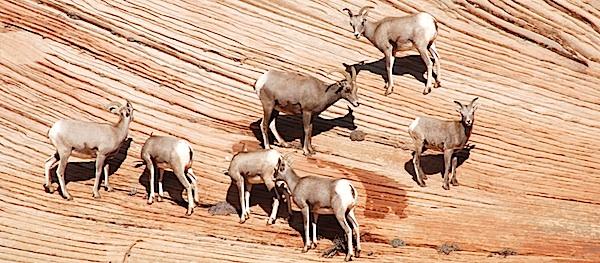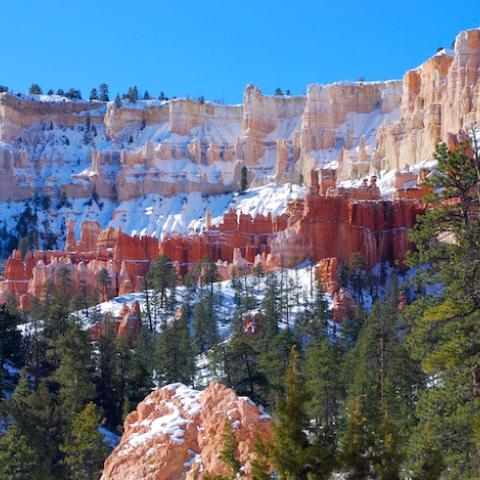
These guys get free entry into Zion National Park, but your cost is going up a bit on July 1/Kurt Repanshek
By the time you read this, it already will be more expensive to visit Cedar Breaks National Monument this year than it was a year ago, and higher fees are coming to nearby Bryce Canyon and Zion national parks, too.
Higher fees went into effect for Cedar Breaks on Friday -- from $4 per person to $5 per person, and in 2017 the entrance fee will inch up to $6 per person. At Bryce Canyon and Zion, the per-vehicle charge will go from $25 to $30 on July 1 in both parks. That fee is good for seven days in the parks. Higher fees also are being implemented for camping and backcountry travel in Zion and Bryce Canyon. Those increases are outlined below.
The higher fees were recommended by National Park Service Director Jon Jarvis in August 2014. At the time, the director called for the 131 units of the National Park System that charge fees to be structured in four tiers, and recommended entrance fee levels for each tier.
At Zion, Bryce Canyon, and Cedar Breaks, all in southwestern Utah, entrance fees had not been raised since 2007.
'During the public comment period, very few of the comments were negative. Politicians, visitors and local community members alike seemed to understand the need for additional funding to help with deferred maintenance projects at parks, especially with the increases in visitation we have seen recently,' said Cedar Breaks Superintendent Paul Roelandt.
'By law, these funds can only be used to help cover costs that are directly related to providing visitor services,' added Bryce Canyon Superintendent Lisa Eckert. 'For example, entrance fees have supported a wide range of projects that improve the park and visitor experiences, including rehabilitating trails, developing and installing exhibits in visitor centers, improving park water systems and other infrastructure, and improving ADA accessibility.'
'This modest increase in fees will allow us to continue to improve facilities and services important to visitors,' said Zion Superintendent Jeff Bradybaugh. 'After carefully considering the impact of a fee increase on visitors and community members, we came to the conclusion that this is the right course of action to help us protect, preserve and share these special places with current visitors and future generations.'
National Park entrance fees are not charged for persons under 16 years of age. Costs for passes covered under the America the Beautiful National Parks and Federal Recreational Lands Pass Program will not be changed at this time. All Interagency Passes available for admission to federal fee areas will remain at the current rates: Annual ($80) ' valid for one year from month of purchase; Senior ($10) ' valid for life for U.S. citizens, 62 years and older; Access Pass ($0) ' valid for life for permanently disabled U.S. citizens; and Military Pass ($0) ' valid for one year from month of purchase for active military personnel.
Zion National Park
Entrance Fees |
Current Fee |
New Fee |
Effective Date |
Per Vehicle |
$25 |
$30 |
July 1, 2015 |
Per Person |
$12 |
$15 |
July 1, 2015 |
Motorcycle |
$12/person |
$25/motorcycle |
July 1, 2015 |
Zion Annual Park Pass |
$50 |
$50 |
No Change |
Watchman Campground Tent Sites |
$16 |
$20 |
January 1, 2016 |
Watchman Campground RV Sites w/Hookups |
$18 |
$30 |
January 1, 2016 |
|
South Campground No Hookups |
$16 |
$20 |
January 1, 2016 |
Watchman Group Camp |
$3/person |
$50 for 7-15 people $90 for 16-25 people $130 for 26-40 people |
January 1, 2016 |
Wilderness Permits |
Current Fee |
New Fee |
Effective Date |
Wilderness Permit 1-2 people |
$10 |
$15 |
January 1, 2016 |
Wilderness Permit 3-7 people |
$15 |
$20 |
January 1, 2016 |
Wilderness Permit 8-12 people |
$20 |
$25 |
January 1, 2016 |
Bryce Canyon National Park
Entrance Fees |
Current Fee |
New Fee |
Effective Date |
Per Vehicle |
$25 |
$30 |
July 1, 2015 |
Per Person |
$12 |
$15 |
July 1, 2015 |
Motorcycle |
$12/person |
$25/motorcycle |
July 1, 2015 |
Bryce Canyon Annual Park Pass |
$30 |
$35 |
July 1, 2015 |
Commercial Tour Rate |
$150 |
$150 |
No Change |
Camping |
Current Fee |
New Fee |
Effective Date |
Sunset and North Campground RV Sites |
$15 |
$30 |
July 1, 2015 |
Sunset and North Campground Tent Sites |
$15 |
$20 |
July 1, 2015 |
Backcountry Camp Sites |
$5 1-2 people $10 3-6 people $15 7+ people |
$5/person |
July 1, 2015 |
Cedar Breaks National Monument
Entrance Fees |
Current Fee |
New Fee |
Effective Date |
Per Person |
$4 |
$5 $6 |
May 22, 2015 May, 2017 |
Cedar Breaks Annual Park Pass |
$20 |
$25 |
May, 2017 |
Camping |
Current Fee |
New Fee |
Effective Date |
Point Supreme Campground |
$14 |
$18 $20 |
May 22, 2015 May, 2017 |



 Support Essential Coverage of Essential Places
Support Essential Coverage of Essential Places







Comments
For a picture of what State "Management" of public lands means, here is an example from today's Salt Lake Tribune. While this particular land is actually owned by the state, it is land that was set aside upon statehood as "school lands." Developers have been drooling over these lands for years, and now the legislature has seen fit to grant some of their wishes. Note the ridiculously low prices of this prime real estate.
But hey, whatever it takes to plunk money into the pockets of their good friends . . . . . .
http://www.sltrib.com/news/2562099-155/utah-to-auction-scenic-properties...
Gee - the lands are being used for exactly the purpose they were established - raising school funds. Horrors!. If it so ridiculously low Lee, why don't you go buy it. It is an auction after all so you have as much right to buy it as "their good friends". As usual, you totally mischaracterize the situation.
This from KSL TV news in Salt Lake:
http://www.ksl.com/?sid=34880651&nid=1070&fm=home_page&s_cid=toppick2
Thanks for the link, Lee. A very interesting article. Is Arches the next Yosemite Valley in terms of severe over-crowding during peak season? The story says the park staff is trying ways to encourage people to visit outside of peak hours and seasons (including higher entrance fee at peak hours, lower fee at off-peak) and even raised the idea of a reservation system during peak season.
A local business owner has a counter-idea: "... the park should do more to accommodate crowds. He points to Yellowstone and Grand Canyon national parks, which provide a good visitor experience for much larger hordes of tourists. He said the National Park Service at Arches should create more parking, access roads, trails, picnic areas and other user-friendly features to encourage tourists to spread out inside the park."
A classic example of the dilemma facing a number of parks.
The article did point out that the issue wasn't crowding in the park it was a back-up at the gate.
Actually, regardless of what the article might have said, the park is usually crammed. Parking lots overflow and cars park off the roads for long distances along main roads near turnoffs to parking lots. In this case, the situation at the gate became so bad that the highway patrol actually stepped in and closed the park entrance road. They sent people who had been waiting on the highway down the road to break up the traffic jam.
Another issue is the first few miles of access road past the entrance station. It is a steep grade with a narrow roadway carved out of the side of a cliff. Traffic glomps up there, too, and sometimes one slow vehicle like a megaRV backs traffic up to the entrance stations.
This article doesn't tell the full story. This is the transcript of a short TV news spot. TV news accuracy is often affected when they try to cram a big story into 30 to 60 seconds. A lot gets left out of those sound bites.
I've not been there for many years, but an interesting quote from the story cited above: "The entire Moab area was experiencing what many residents say was the heaviest traffic, by far, that they have ever seen. For much of the weekend, cars headed for many destinations in the region created bumper-to-bumper traffic all the way through town, for a distance of several miles. Many residents say they were astounded by what they saw."
Sounds like, for better or worse, the area has been "discovered."
Previous stories on the Traveler have discussed the lack of parking at popular spots in the park - and the usual solution to expand parking lots is underway for at least one location. Opinions will vary about whether that is the best long-term solution.
Its your article Lee, if you don't believe it why did you post it? But what is your point anyway? People are going to the parks. Is that a bad thing?